Rabbit indoor breeds like the American Rabbit and the Mini Rex are great indoor rabbit breeds that are calm and gentle. With plenty of exercise always being a necessity for your indoor pet rabbit, a roomy cage allows for plenty of movement and freedom throughout the day. Keep in mind that your rabbit still needs plenty of free time each day to hop around outside his cute cage.
According to the American Rabbit Breeders Association (ARBA), there are 49 rabbit breeds to choose from. That said, it’s important to learn about the breed characteristics, since it only makes sense to focus on how domestic rabbits need to be handled and looked after.
Most rabbits need to be handled daily to keep them calm, and should not be left alone in their cage every day. Additionally, some rabbit breeds do not make for a good children’s pet.
Most rabbit breeds make good companions for a pet parent that has the necessary amount of time to spend. With no two bunnies being similar in temperament or needing the same products, pet parents should spend time researching accessories and nutrition that will help their pets live a longer and happier life. Let’s take a look at the most popular indoor rabbit breeds.
The Best 10 Indoor Rabbit Breeds
1. The American Rabbit
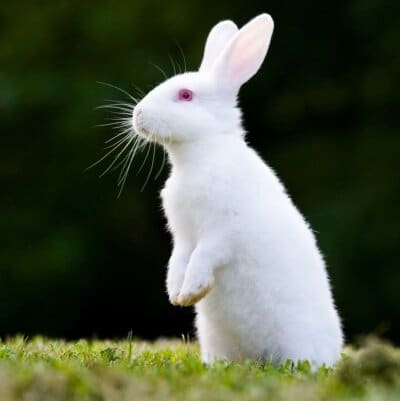
This is a rare breed according to the American Livestock Breed Conservancy. They come in two colors which are blue (dark grey) and white, with a maximum weight of 12 pounds. The white variety originated from white mutants, and came in much later. They are medium to large in size, and have a lifespan of up to 8-12 years. This breed has red eyes.
The American Rabbit makes for a good companion for older children, and adults. They are calm, and laid back. This rabbit breed has a semi-arch body type, with narrow ears that are tapered and well-proportioned in length. The coat is silky, soft and has short flyback fur.
Grooming with this breed is easy, yet rabbits should not be bathed since they are easily stressed out. With rabbits being good self-groomers, cleanliness is never a problem. Rabbits do shed, and when they molt, will require extra grooming.
The American Rabbit breed can be spayed as early as 4 months of age, with veterinarians recommending 6 months as the best age for spaying. Bucks (male rabbits) can be neutered at 3 ½ months. Although this is a very healthy breed, they can be susceptible to hairballs, uterine tumors, snuffles, myxomytosis, calicivirus, and overgrown teeth. That said, keep in mind that if you feed a high-fiber diet, overgrown teeth are preventable. Consult with your veterinarian for the best advice when it comes to rabbit veterinary care.
2. Lionhead Rabbit
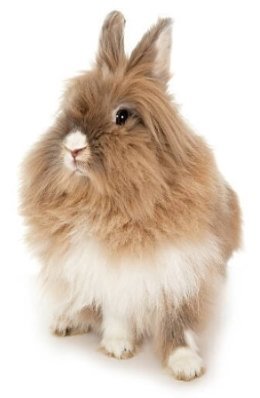
This breed carries long hair on both neck and back. It is small to medium in size, and looks muscular. With this breed being so people-friendly, pet parents need to realize that they need more maintenance than some of the other rabbit breeds. Regarded as “lap bunnies”, with the Lionhead being very compatible, they still need to be gently handled at all times, and require plenty of exercise.
The Lionhead carries a mane of around 2 inches long, and benefits from plenty of regular grooming. Some rabbits may carry a single or double mane. The coat is thick and wooly. They are around 31 pounds in weight, with a lifespan of 8-10 years.
By providing the very best in veterinary care, spacey housing with plenty of exercise and high-quality nutrition, you’ll be encouraging longevity. Rabbits need to avoid all stress!
The most common health problems with Lionhead Rabbits are the following: Viral Haemorrhagic Disease (VHD) and myxomatosis.
3. Mini Rex
The Mini Rex is a European breed that weighs between 3.5 to 4.5 pounds. This is a small breed that carries long erect ears, and also has a short neck. The temperament is sweet and calm, and this breed does well with less grooming than some of the other rabbit breeds.
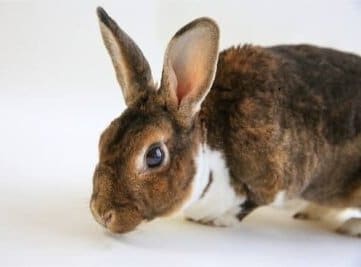
The Mini Rex has a short, velvety coat and carries a recessive gene that allows for its coat to stand out, instead of lying flat against the skin. The Mini Rex has a thick undercoat which requires extra grooming. Coats come in many colors like sable, Himalayan, lilac, lynx, blue, castor, as well as in tricolors, and patterned.
They are calm and friendly with children, and are very healthy as a rabbit breed. This is a good rabbit breed for those that are new to having rabbits as pets. They have a lifespan of 5-7 years, and are healthy as a breed. That said, ensuring that your indoor pet rabbit has regular veterinary care, and plenty of exercise combined with a high-quality diet means that your rabbit can have a longer life. The Mini Rex may develop sore hocks due to lack of fur on their feet. They also have curly whiskers which need to be trimmed regularly. Consult with your veterinarian about how much to trim off.
4. Holland Lop
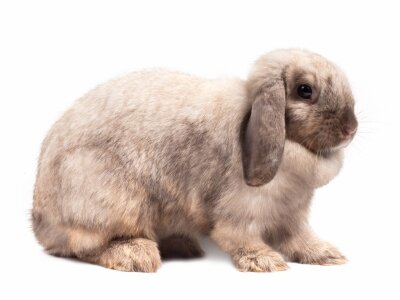
Originally from the Netherlands, the Holland Lop is a small compact rabbit breed. With a broad head and stocky body, it has a crown of fur on the back of the head. The body should be well-balanced from one end to the other. The body is muscular with wide shoulders.
The ears are lopped, and the fur is thick and shiny when fed a high-quality diet. The head is large with a short and wide muzzle. That said, this breed looks like a miniature Bull Dog. The coat is 1 inch in thickness. Weighing between 2-4 pounds, the Holland Lop does well with children and adults alike.
Grooming is easy with this small breed, although in the summer they shed a lot. As usual, no bathing is required for rabbits, since this is stressful and could kill them. This is a healthy indoor rabbit breed that comes in a variety of colors, and has a lifespan from 7-14 years. The Holland Lop does well with plenty of outdoor free- exercise. They make for popular show rabbits that have a great temperament, and are easy-to handle.
5. The Dutch Rabbit
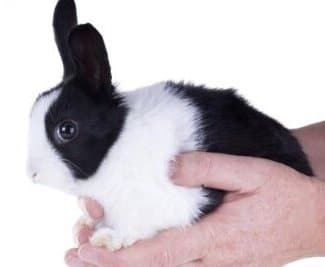
This is another compact breed that weighs from 4 to 5.5 pounds. A calm and easygoing indoor rabbit breed, the Dutch rabbit is one of the oldest breeds. That said, this breed originated in Flanders, Holland, and ended up being a popular breed in the UK.
The Dutch rabbit has a roundish body shape that is small with a rounded head. The ears are short and broad, with the fur being flyback. The front legs are shorter than the back legs, and the coat, short and shiny. That said, this breed is easy-to-groom even throughout their seasonal molting period, when daily brushing is required.
The Dutch rabbit comes in several colors with each type of Dutch rabbit identified by its coat color. All will have dark colored ears and romps with white fluffy bands from the tops of their shoulders to their bellies. The legs are also white, and so is the blaze running midway on the front of the face.
The Chinchilla Dutch rabbit is dark brown or blue-grey in color. The white fur is also a speckled grey. The Chocolate Dutch rabbit carries a brown coat and has brown or red eyes. The Steel Dutch rabbit is mostly black in color, with some cream coloring on its body tips. The eyes are brown.
Finally, the Tortoise Dutch indoor rabbit carries a bright orange and cream coat with dark brown eyes. There are no health concerns with the Dutch rabbit apart from the usual health concerns. As usual consult with your veterinarian for the best rabbit care.
6. Blanc de Hotot
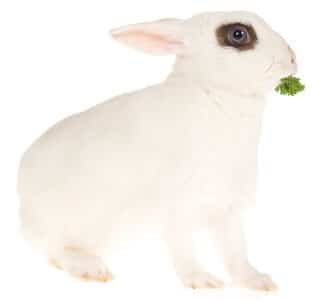
This rabbit breed originates from France, and has specific eye markings that look like eyeliner has been applied to the eye. With a white body, this large rabbit breed makes for a wonderful companion. Good with children and adults, it is sweet and active.
The Blanc de Hotot weighs from 8-11 pounds, and has a lifespan of 7-10 years. It carries a small tail, and medium sized ears that are upright. The coat is short and sleek, and the fur is rollback. It also has extra-long guard hairs that allow for the shimmery sheen. This is a low maintenance rabbit breed that does well with plenty of outdoor exercise. With grooming kept to a minimal of 1-2 times a week during shedding season, and bi-weekly when they are not shedding.
This indoor rabbit breed is a solely white rabbit breed with brown eyes. The black “eyeliner” marking is the only marking that this breed has. Although not susceptible to any hereditary diseases, pet parents need to watch out for overgrown teeth. This can be prevented by feeding a high-quality diet that has plenty of hay. Consult with your veterinarian for advice if your pet rabbit has this condition. Ear mites may also pose to be a problem since it affects all rabbit breeds. As usual, keep your pet rabbit away from aggressive dogs or large animals that may hurt him, especially when outdoors. This is a docile and friendly breed that if socialized can become your dog’s best friend.
7. The Californian Rabbit
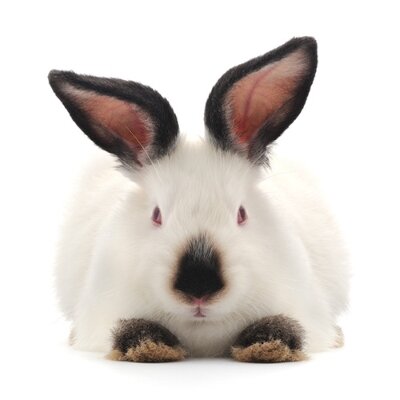
This rabbit breed has a thick coat, and is a cross between a Chinchilla and a Himalayan. It is a super friendly rabbit breed that does well with adults and children. This rabbit breed is large, and weighs from 8-10.5 pounds. It has a lifespan of 5-10 years. Since it is an energetic rabbit breed, it may need more exercise than usual, and does well spending time outdoors in a protected run.
The indoor Californian rabbit is of a muscular body type with full shoulders and powerful hindquarters. The coat is white, and has the dark Himalayan markings. The black markings can also be found on their feet, nose, ears and tail. The ears are upright and broad. The coat is thick and course, and is not soft or silky. It is short with a thick undercoat. Grooming is easy, with more maintenance required during the spring when shedding occurs. This rabbit breed has pink eyes, and looks almost albino like.
The Californian rabbit like all rabbit breeds needs to be kept away from drafts and the cold. This is a healthy rabbit breed with no health issues. That said, regular veterinary consults are necessary so that your pet rabbit is kept in good health.
8. The Mini Lop
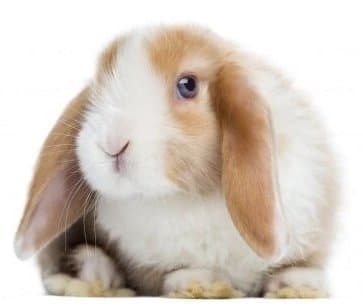
This incredible rabbit breed can weigh as much as 6 pounds, and is very sweet. It is of medium size, and weighs from 4.5 to 6 pounds. With a lifespan of 5-10 years this affectionate bunny makes for a good pet. The Mini Lop is easy to care for! This breed has a sweet disposition and enjoys human contact. With medium sized ears that droop downwards, the indoor Mini Lop may be prone to ear infections.
Although from Germany originally, the Mini Lop is popular worldwide. This breed has a compact small body that is heavily muscled and well-rounded. That said, this rabbit breed has a short neck and broad head. The coat is of medium-length rollback, and there are numerous colors like pointed white, agouti, broken, ticked, wide band, self and shaded. There are also many patterns and shades of the Mini Lop rabbit.
This is a healthy rabbit breed with few health concerns. It is necessary to keep rabbits away from flies which lay eggs that could eat them alive. That said, allow for your pet rabbit to enjoy the outdoors, but also have him indoors. Ear mites can be a problem, as are overgrown teeth.
Regular veterinary care is top priority when it comes to your pet rabbit’s health and longevity. Look out for head shaking, ear scratching, and signs of pain caused by parasites. Keeping your pet rabbit indoors during the hot summer months is important since all rabbit breeds are prone to heatstroke.
9. The Rex Rabbit
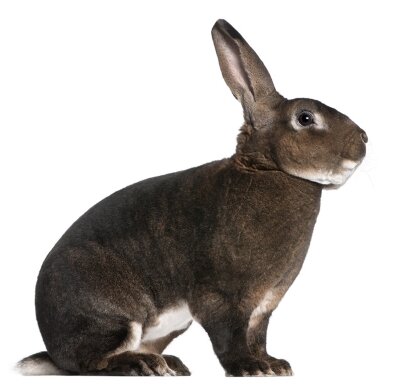
The indoor Rex Rabbit is a large rabbit breed that can weigh from 7.5-10.5 pounds. It has a lifespan of 5-6 years, and is child friendly. This breed is intelligent and playful, and originally came from France. It is a well-proportioned rabbit breed that has a medium body length with a broad head, that is in balance with the rest of the body. With erect ears that are medium in length and thickness, the Rex Rabbit has legs that are short and straight.
The coat is close to ½ inch short and is thick and soft, and looks like velvet. The fur stands out against the body, and requires little grooming or the coat gets damaged. A clean towel that is slightly wet is sufficient to use as a wipe. The indoor Rex Rabbit comes in many colors like chinchilla, castor, black, white, opal, seal, amber, and Californian. Coat color may also be broken and mixed with other coat colors.
With good socialization from a young age, the Rex Rabbit can be easily embraced as a family member. They enjoy free hopping outside of their cage, and enjoy interacting with their pet parents. Like all rabbits, it’s necessary to feed them a high-quality diet with 70% hay, and to avoid overgrown teeth.
This is a healthy rabbit breed with no health issues. That said, pet parents need to regularly check their rabbit’s mouth for overgrown teeth, and ears for mites and infection. It’s also good to watch out for GI stasis, and to prevent this by feeding plenty of hay 24/7. Rabbits swallow hairballs which can cause an intestinal issue.
10. The Florida White Rabbit
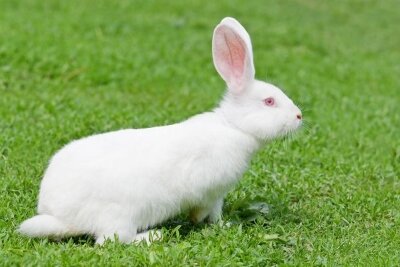
This is a mini to small indoor rabbit breed that weighs from 4-6 pounds. With a lifespan of 5-8 years, the friendly Florida White rabbit breed is one that is quiet and relaxed. The body shape is compact, and it has a high-quality show coat that is shiny.
It has a short neck and a compact body. The erect ears are thick, but not large, and the body well-developed. The ears can also fall on either sides of their heads. This is a well-muscled bunny with strong hindquarters.
The coat is smooth and short, and does not need much maintenance. Grooming one a week should suffice, unless it’s shedding time. The coat is white without markings, and the eyes red. The Florida White has no health issues, but preventative measures need to be taken to prevent overgrown teeth, vitamin D deficiencies, as well as ear mites. Be sure to socialize your pet rabbit from a young age, so that it can interact comfortably with other people and animals. This is a docile and sweet rabbit breed that does well with children and adults.
All rabbit breeds need to get annual health checkups. Your veterinarian will examine your rabbit’s mouth, jaw, and ears as well. There are also special considerations when handling pet rabbits. Children need to learn how to hold rabbits properly, so that the hind end is always supported to prevent injury.
Pet rabbits need to be kept out of hot weather and poorly ventilated hutches or cars. Domesticated pet parents do not do well in temperatures below 50 degrees F. The same applies to heat exposure. Rabbits can die in temperatures above 80 degrees F. That said, supplying your pet rabbits with an endless supply of chew toys and hay will prevent overgrown teeth and dental issues.
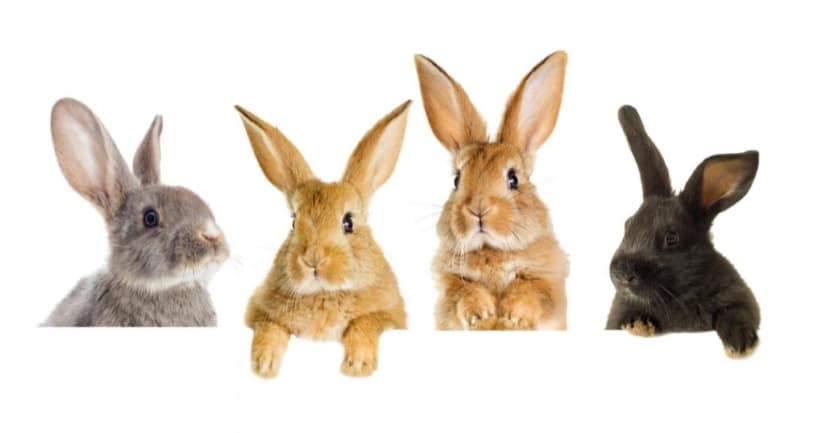
I have been wanting to adopt a rabbit and didn’t know which kind would be best for me.
Thank you so much for this informative guide. It helped so much.
Thanks again, Gail
I have a sable and he is the sweetest rabbit I have ever owned. I wouldn’t trade him for anything
My cousin has been thinking about getting a pet rabbit so that she can have a companion with her. Thanks for explaining how a lionhead rabbit needs more maintenance, and may need to have regular grooming. She would really like to get some help from a professional to groom them properly.
Great info and fun to read Thank you
I have a giant Flemish rabbit. He’s the sweetest baby ever!
I alwasw wanted a bunny i really like the dutch rabbit!
I love bunnies. I have a lionhead
I’ve had house bunnies for 18 years. Mostly rescues or “broken” ones. I lost my last two rescues recently (11 or 12 yrs old, and have no idea what breeds they were… ) have been trying to find another mini Rex, but all seem to be located too far away from me, and I refuse to over stress them. I have actually spent most of my bunny years advocating and educating others on house/companion rabbits. Help would be appreciated! ~buns~
Please remember that rabbits are wonderful, but require work be put into caring for them. So many people buy a rabbit from a pet store (especially around Easter for their kids) thinking they will mostly take care of themselves and then when they realize that keeping a cage from smelling requires constant cleaning, and that not all rabbits want to snuggle like a puppy they just decide to get rid of them. I live in Las Vegas and stupid people seem to think they can just release a petstore rabbit into the desert and they will be fine even though these Rex and Mini Rex rabbits are not equipped to survive in the extreme heat like the Nevada Desert Hare, and the white ones do not blend into the landscape and can easily be picked off by predators. My mother has found 2 very sweet friendly rabbits recently who came right up to her looking for love and hoping for proper food, and a few years ago found her first petstore rabbit while on a walk with her dogs in the desert near her house. PLEASE do not get a pet you are not ready to care for, and PLEASE do not think a petstore rabbit is equipped to survive like a native species when you get sick of caring for it!
Thanks lots
I have the American rabbit an he is horrible a not very nice
I have a New Zealand house rabbit. She is wonderful. They should be on the list. I got her from a rescue she’d been in for 118 days and she instantly took to our large animal family without a glitch.
My New Zealand rabbit Nevah is the absolute SWEETEST little girl. Got her as a rescue and my golly she is so patient and loving with my daughters. She was left in a hallway all alone. Now she is in loving care right where she belongs!!!! Our first bunny and we love her!!!!! I’am Very OCD about cleaning her pen and litter box but that’s okay. She is worth it!!!!! We have had her since March and her playful side is coming out and she is hilarious!! 😂
Can they be taught to use a litter box?
Yes, rabbits can be taught to use a litter box. Like many pets, with the right guidance and consistency, rabbits can learn to use a litter box for their needs. It’s important to choose an appropriate litter and litter box, and to place it in an area where your rabbit spends a lot of time. Positive reinforcement and patience will greatly assist in this training process.